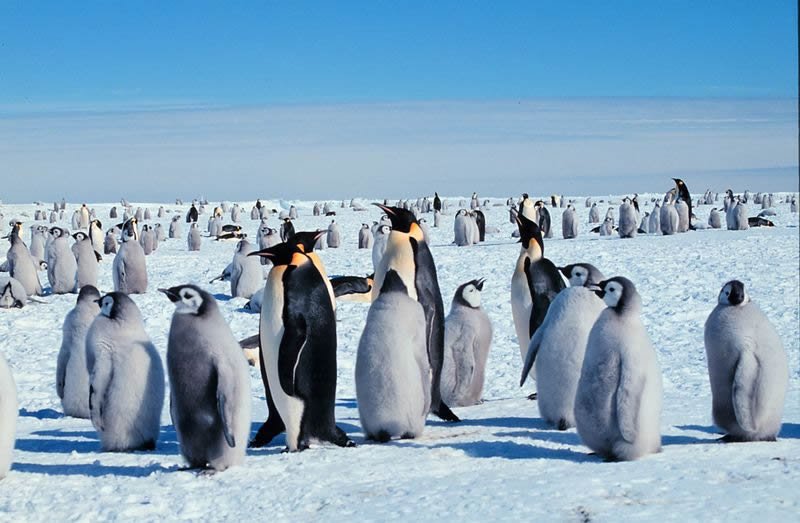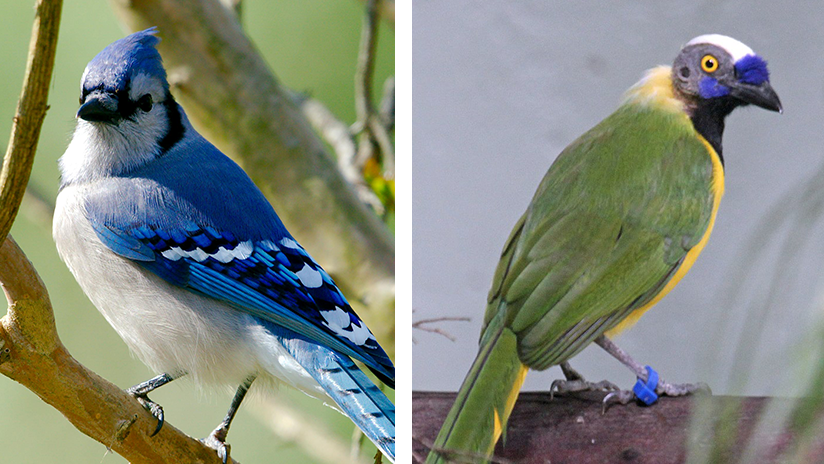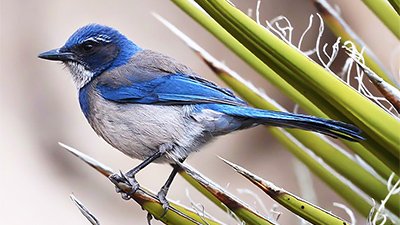
Emperor Penguins: Equipped for Life at the “Bottom” of the World
Life as an Emperor Penguin
The stately bird with tuxedo-patterned feathers is on a mission. She glides through the Antarctic waters after catching her last bellyful of fish. She shoots out of the water, leaping up to the ice pack above. Without a calendar to count the days, somehow she knows the time has come to return.
The journey will not be easy. Up to 124 miles (200 km) of ice may lie between her and her family, which is depending on her back at the rookery where her colony lives. While she can fly through the water at 15 miles per hour,1 her wings are not designed to fly through the air. Her webbed feet waddle the icy miles back home. Sometimes, she can speed up by sliding along on her belly.
Back at the rookery, her mate waits along with the rest of the males. A couple months ago in June, she left him there to guard the single egg she laid and rolled atop his feet, a difficult and dangerous transfer. The life inside the egg would die within mere minutes of contact with the freezing ice. On top of the father’s feet and underneath a fold of skin, the egg is incubated at 95 degrees Fahrenheit (35 degrees C), even through subzero temperatures outside. When blizzards blow, the group works together to stay alive. Huddling tightly together, penguins take turns standing on the outside of the pack and then shuffling to the center to warm up. The male stands with the egg on his feet for two brutal winter months. Since the male cannot eat without abandoning the egg, he loses nearly half of his body weight during this time.
At just the right time, often on the precise day the eggs are hatching, the females return. The ruckus seems confusing as thousands of birds call to one another. But in the middle of the uproar, each female can find her mate because each bird has a unique call. She has stored food in her stomach and regurgitates this partially-digested food to feed the hungry chick. Leaving the chicks in the care of the females, the males head to the ocean for food. The parents will then take turns filling up and bringing back food for the chicks.
It takes five months for the chicks to grow up. When their gray down feathers molt and are replaced by juvenile feathers, the chicks are ready for ocean life. With the austral spring approaching, the ice pack has been melting, making the journey to the sea shorter. The parents don’t need to teach their chicks how to swim since penguins are designed for water life. Penguins seem to enjoy the water: they even take turns sliding down the ice on their bellies for a splash into the sea and then hop out for another go.2 Despite the extreme temperatures they endure, the hardy penguins thrive in the Antarctic waters.

Image by Kobac, via Wikimedia Commons.
Snapshot
- The emperor penguin is the largest penguin species in existence. Male and female alike grow to around 45 inches, which is about the height of a child in kindergarten. Fossils have been found of extinct penguin species that were close to five feet long! Male and female adults weigh approximately 84 pounds.
- Emperor penguins inhabit Antarctic waters at the “bottom” of the earth, and their numbers are estimated between 270,000–350,000 birds.3 Antarctica is the coldest place in the world, and temperatures may drop to minus 80 degrees Fahrenheit (-62 degrees C). The wind chill makes it feel even colder since the wind can blow around 120 miles per hour (193 km/h).
- Penguins are equipped for the cold with long, uniform, overlapping feathers that they waterproof with oil from a special gland, as well as a layer of warm air between their feathers and subcutaneous fat layer. The emperor penguin has been recorded diving to 869 feet (265 meters). When it is deep-diving, its heart compensates by slowing 15 percent. Unlike other birds with light bone structures, the penguin’s bones are dense to combat barotrauma (pressure related trauma) during dives. Dives underwater usually last two to eight minutes, but one penguin was recorded staying underwater for 18 minutes.
- Penguins eat a variety of marine life such as fish, krill, and squid. The penguin’s tongue has barbs, which point toward the throat to secure prey.
- Penguins can find their way back to their breeding colony from long distances away at sea. Their navigational ability may rely partly on the sun.
- Emperor penguins are long-living birds, surviving around 20 years in the harsh wild. Their predators are sea animals like leopard seals, orcas (killer whales), fur seals, sea lions, and sharks. Chicks are at risk to bird predators like the Antarctic Giant Petrel. In fact, only about 20 percent of chicks make it to their first birthday.
- In the water, the penguin’s tuxedo coloring camouflages it from predators. Sea predators from below will see the penguin’s white stomach, which blends with the shiny surface.
Divine Design
Although God created the penguin kind on Day Five of the Creation Week (Genesis 1:20–23), the emperor penguin species likely did not exist until a later time. The world was perfect at that time, so penguins may not have had to endure freezing temperatures. In God’s wise and caring foreknowledge, He equipped the original penguin kind with the genetic information necessary for penguins as hardy as the emperor penguin to exist today.
After the Flood, the penguins that came off the Ark multiplied, and different species within the kind resulted from a variety of factors like genetics and the environment. This is not molecules-to-man evolution because genetic information was lost or altered, not gained, and the new species were all within the penguin kind—they didn’t become other kinds of birds or animals.
Evolutionists, on the other hand, assume penguins came from birds of flight that originally evolved from dinosaurs. However, the fossil record reveals no evidence of their claim. Even though a variety of penguin fossils have been discovered, they all have distinct penguin features and were flightless birds.
The popular documentary March of the Penguins was applauded by some creationists because it shows the remarkable design of the penguins instead of focusing on evolution. Some conservatives even pointed to the penguin as an example of moral values—such as being monogamous and pro-life. Yet we must be careful to never let the animal kingdom be humanity’s basis for morality. Indeed, some animals show behavior that humans would call polygamous or cannibalistic.
Mankind is distinct from the animals, being made in the image of God (Genesis 1:26). God has given man a conscience to convict us of right and wrong (Romans 2:15). He has given us His Word, which is truth (Psalm 119:160). And He has given us His Son who lived righteously and died for our sins: “Who Himself bore our sins in His body on the tree, that we might die to sin live to righteousness. By his wounds you have been healed” (1 Peter 2:24). Those who turn from their sins and trust Christ will receive God’s forgiveness and eternal life.
Creation Corner
Remember that everything was cursed because of man's sin (think specifically of the ground and serpent mentioned in Genesis 3). Death then intruded upon God’s perfect creation, so animals, people, and plants have had to fight for survival ever since. Because of the Curse, traits developed that would have been unnecessary before Adam sinned, like venom and stingers for attack and defense. Keep in mind, though, that not all deadly looking features necessarily had to develop! Fruit bats are a great example of how mean-looking teeth can work just as well for ripping apart vegetation, not flesh! For more about how and why deadly structures are now a part of our world, see “”
Of course some animals are impressive for their beauty and design, too. Seeing things through the lens of Scripture, we see an all-wise and intelligent God who spoke animals into existence in a perfect world that was soon marred by sin and death. We can praise the Creator for a remnant of that incredible beauty and design still. And God has also thus provided us with examples of his intelligence and provision that we can put to good use in biomimicry. Join us in giving glory to God for his loving care for us and his creation, despite the curse.
– Editor
Footnotes
- “Emperor Penguins,” accessed January 10, 2011, http://www.keithdreher.com/emperor.html.
- Incredible Creatures That Defy Evolution III, dir. by Steve Greisen (Reel Productions, 2005 DVD).
- del Hoyo, J., Elliott, A. and Sargatal, J. eds. Handbook of the Birds of the World. Vol. 1. Lynx Edicions, Barcelona.

Answers in Genesis is an apologetics ministry, dedicated to helping Christians defend their faith and proclaim the good news of Jesus Christ.
- Customer Service 800.778.3390
- Available Monday–Friday | 9 AM–5 PM ET
- © 2025 Answers in Genesis


